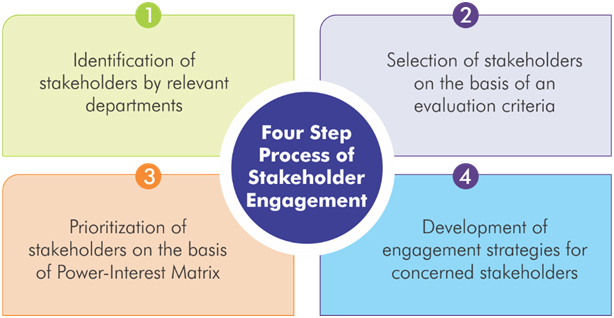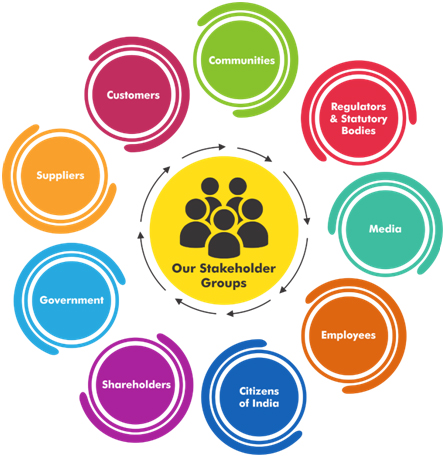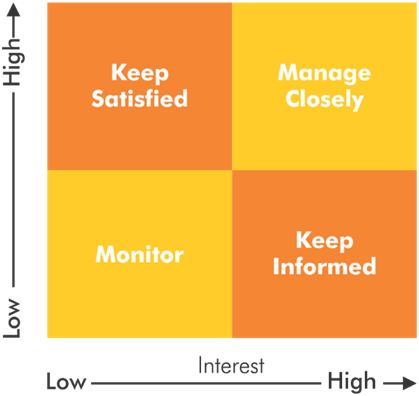Stakeholder engagement at NTPC is an ongoing process wherein the company interacts with its stakeholders at different levels to understand and address their expectations and collaborates with them for creating shared value. NTPC has built a constructive relationship with all its stakeholders since more than 4 decades of existence based on mutual trust , transparency, ethics and accountability. The continuous two-way dialogue process with stakeholders along with their feedbacks on various issues concerning the company’s operations has enabled us to establish sustainable relationships with the stakeholders as well as ensured the company’s growth and achievements.
NTPC has a structured stakeholder management mechanism in place at all establishments. A 4 step model as outlined below is key to our successful stakeholder management process.

FOUR STEP PROCESS OF STAKEHOLDER ENGAGEMENT
a) Identification of Stakeholders
With a pre-defined periodicity, brainstorming sessions are conducted at 3 levels: project/stations, regional headquarters and corporate functions. These sessions involve across functional leadership team comprising Head of the projects(HoPs), Head of the departments(HoDs) & Sectional Heads etc. For identification of stakeholders, all the stakeholders are first listed down, without any screening criteria based on their interest in NTPC in the current scenario & probability of gaining interest in the future as well.
Theses stakeholders are clubbed under the nine broad categories of:

b) Selection of Stakeholders
After developing the first list of stakeholders, further analysis is done based on the following attributes to furtherdetermine which stakeholders are most useful to engage with.

c) Priortization of Stakeholders
The final list of stakeholders is then prioritised using a power - interest matrix to devise the corresponding engagementstrategies.

d) Framing of Engagement Strategy
A detailed engagement process is created with information about frequency, agenda, touch points, analysis, review etc. forconcerned stakeholders. Interfacing functions/ departments are designated as the owners of theconcerned engagement process and have the responsibility of ensuring end to end coverage. They are also entrusted withidentifying and addressing the critical concerns. The issues/ concerns raised by various stakeholders during theengagement process along with the Company’s response towards these issues are presented in the Integrated Report.
CUSTOMER SATISFACTION INDEX (%)
Customer focus is a core value at NTPC, driving strong relationships with its clientele through a robust Customer Relationship Management (CRM) framework. This comprehensive approach includes customer support services, tailored training programs, interactive platforms, and continuous stakeholder engagement. By proactively addressing customer needs and sharing valuable insights, NTPC fosters collaboration and long-term partnerships, reinforcing its commitment to excellence and customer satisfaction.

OUR STAKEHOLDERS
| Stakeholder Group | Modes of Engagement | Frequency of Engagement | Key Concerns |
|---|---|---|---|
| Government of India | • Minister & Secretary level review • Meetings with MoP, MNRE, MoEFCC, MoC, DAE, DPE, Parliamentary Committees, CEA, NITI Aayog etc. | • Quarterly • Need based | • Ample power generation capacity • 24x7 affordable power to all • Maximizing infrastructure utilization • Social development • Climate Change & Environment conservation • Promote Govt. schemes (viz. Make in India, Skill India, Swachh Bharat Mission, etc.) |
| Regulators | • Public hearings • Statutory audits & inspections, • Meeting for clearances, consents and compliances | • Need based • As per statutory provisions | • Optimum electricity tariff • Compliance with changing business environment |
| Communities & NGOs | • Public hearings • Village Development Advisory Committee (VDAC) • Public information centers • Project-based stakeholder meets | • Need based • Annually | • Infrastructure development • Quality of life • Employment opportunities • Land acquisition and R&R issues • Increased community involvement |
| Investors & Lenders | • Analyst and investors meetings • Annual general meeting • Review meets with bankers (Domestic and Foreign) | • Quarterly • Annual • Regular | • Improving Rol •Climate change & business sustainability •Risk and governance compliance •Increased disclosures on Environment, Social and Governance(ESG) aspects |
| Employees | • Participative forums • Communication meetings • Employee surveys • Intranet and website • Trainings and workshops • Internal magazines | • Defined frequency of concerned Fora • Need based | • Professional growth • Work life balance • Health, safety and security • Timely resolution of grievances • Transparent appraisal and promotion cycle |
| Stakeholder Group | Modes of Engagement | Frequency of Engagement | Key Concerns |
|---|---|---|---|
| Customers | • Regional customers meets • Regional power committees (RPCs) • Commercial meetings/interactions • Technical coordination committee • Operation coordination committee& • Business partner meet • Customer support services | • Quarterly • Monthly • Yearly • Need Based | • Resolving commercial issues • Resolving technical issues |
| Suppliers | • Pre-bid conference • Suppliers meets,Vendor enlisting • NTPC website | • Before tendering • Need based | • Transparent dealings • Timely payments • Fair opportunities • Sustainable Supply Chain |
| Media | • Press releases • Press conferences | • Need based • Event based | • Information sharing • Increased transparency |
| Indian Citizens | • Right to Information (RTI) Act queries • NTPC website | • Continuous | • Community development • Environmental issues • Progressive organization |

